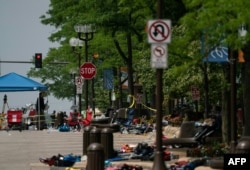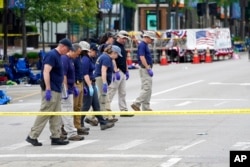This week’s Independence Day massacre in a Chicago suburb is highlighting the challenge now facing U.S. law enforcement and homeland security officials — an environment in which almost any public event could come under attack with few, if any, signals for authorities to detect in advance.
The U.S. Department of Homeland Security has been warning for months of a “dynamic and complex” threat environment, most recently in a National Terrorism Advisory System (NTAS) Bulletin last month, cautioning a variety of factors from personal grievances to current events could spark the next attack, with public gatherings a likely target.
Yet even armed with that knowledge, authorities were not able to see any signs or find any evidence that might have allowed them to stop the mass shooting at the Highland Park, Illinois July Fourth parade which killed seven people and wounded at least 30 others.
“The shooting appears to be completely random,” Chris Covelli, a spokesperson for the Lake County sheriff’s office, told reporters Tuesday.
“We have no information to suggest at this point it was racially motivated, motivated by religion or any other protected status,” he said.
What investigators are finding, however, is a trail of evidence, mostly on social media, that suggests the suspect, 21-year-old Robert Crimo III, was veering toward violence.
Crimo, an aspiring musician with the stage name Awake the Rapper, recently posted videos and songs, some ominous and violent, on social media sites.
Officials said Crimo had also been brought to the attention of police twice — in April 2019 for an attempted suicide and in September of that same year for threatening family members.
Additionally, law enforcement officials said it appears Crimo was planning the attack on the parade for weeks, buying a rifle, picking out a location and planning an escape.
So how did the Crimo fly under the radar?
Some terrorism and security experts point out the suspect did not appear to subscribe to any sort of easily recognizable ideology.
“While it’s too early to say what motivated the Highland shooter, his scattered online profile certainly points to his presence in some disturbingly violent and nihilistic spaces,” according to Amarnath Amarasingam, a terrorism researcher at Queen’s University School of Religion in Ontario, Canada.
“A lot of quite obscure internet subcultures are pushing young people towards the breaking point,” Amarasingam told VOA. “These spaces are deliberately designed to disconnect individuals from reality, lower their inhibitions to engage in violence.”
Additionally, Amarasingham warned these sites push individuals “to see incoherence and nonsense as virtuous.”
It is a culture than can be confounding.
“Traditional extremism frameworks have a hard time with this because we are trained to demand a level of coherence in ideologies. This is not that,” Amarasingham said. “People who look at his attendance at Trump rallies and so on are going to miss a major piece of this story.
In a statement Tuesday, U.S. Homeland Security Secretary Alejandro Mayorkas described the attack on the Highland Park July Fourth parade as “yet another mass shooting” and promised his department would redouble its efforts to prevent future tragedies.
“The security of our homeland requires more,” Mayorkas said in a statement. “It requires all of us, together, to address the epidemic of targeted gun violence, including the development and implementation of new community-based models of prevention and intervention.”
What federal government officials, whether at the Department of Homeland Security or other agencies, can do about access to guns is unclear, especially after last month’s Supreme Court ruling, which struck down a New York State gun control law as unconstitutional.
For now, Homeland Security officials say they will focus on efforts like the Center for Prevention Programs and Partnerships, which provides financial resources and other assistance to communities across the country to help stop young people from radicalizing.
U.S. states are also offering help to local communities.
The New Jersey office of Homeland Security and Preparedness (NJOHSP) told VOA it routinely “tracks events and works closely with communities, organizers and venues to help prevent, mitigate and respond to any potential threats.”
“We encourage interfaith communities, businesses and the general public to connect with their local law enforcement,” the NJOHSP added in an email. “These partnerships are better forged prior to any potential crises unfolding.”
There are concerns, however, that such programs are not enough.
“There is a resistance in general, either from kind of an ideological perspective, in some cases because of historical mistrust of what the federal government has been doing,” said Sam Lichtenstein, director of analysis at the Risk Assistance Network and Exchange, also known as RANE.
“But even in communities that are more receptive to some of these things you can have as many local authorities that are interested and eager to participate as you want, but if it doesn’t really filter down to the really local grass roots, which is the hardest thing to do, it’s unlikely to really be successful,” he told VOA.
There are also doubts about the reliability of counting on Americans to report concerns — and then getting needed help for those trending towards violence.
“What’s tragic here [in Highland Park] and what you see in a lot of these incidents is that now we all look back and we find some proverbial red flags,” said RANE’s Lichtenstein.
“Violent, inciteful rhetoric is becoming normalized in society and that is most definitely making it harder to pull out what’s really concerning from social media and other statements,” he said. “For many people, even if they hear concerning things, it doesn’t immediately kind of trigger for them, ‘Oh, I should be reporting this.’”


